The UNE 0087 standard defines for the first time in Spain the key principles and requirements for creating and operating in data spaces
On 17 July, the UNE 0087 Specification "Definition and Characterisation of Data Spaces" was officially published, the first Spanish standard to establish a common framework for these digital environments.
This milestone has been possible thanks to the collaboration of the Data Space Reference Centre (CRED) with the Spanish Association for Standardisation (UNE). This regulation, which was approved on June 20, 2025, defines three key pillars in adherence to data spaces: interoperability, governance and value creation, with the aim of offering legal certainty, trust and a common technical language in the data economy.
For its creation, three working groups have been formed with more than 50 participants from both public and private entities who have contributed their knowledge to define the principles and key characteristics of these collaborative systems. These working groups have been coordinated as follows:
- WG1: Definition of Data Spaces and Maturity Model.
- WG2: Technical and Semantic Interoperability.
- WG3: Legal and organisational interoperability.
The publication of this regulation is, therefore, a reference document for the creation of secure and reliable data spaces, applicable in all productive sectors and which serves as a basis for future guide documents.
In this way, to offer guidelines that facilitate the implementation and development of data spaces, the UNE 0087:2025 specification was created to create an inclusive framework of reference that guides organizations so that they can take advantage of all the information in an environment of regulatory compliance and digital sovereignty. The publication of this regulation has a number of benefits:
- Accelerate the deployment of data spaces across all sectors of the economy.
- Supporting sustainability and scaling/growth of data-sharing ecosystems.
- Promoting public/private collaboration, ensuring convergence with Europe.
- Move towards technological autonomy and data sovereignty in ecosystems.
- Promote the discovery of new innovative business opportunities by fostering collaboration and the creation of strategic alliances.
Within the specification, data spaces are defined, their key characteristics of interoperability, governance and value generation are established and the benefits of their adhesion are determined. The specification is published here and it is important to add that, although there is a download cost, it is free of charge, thanks to the sponsorship of the General Directorate of Data.
With this tool, Spain takes a firm step in the consolidation of cohesive, secure data spaces aligned with the European framework, facilitating the implementation of cross-cutting projects in different sectors.
We live in a constantly evolving environment in which data is growing exponentially and is also a fundamental component of the digital economy. In this context, it is necessary to unlock its potential to maximize its value by creating opportunities for its reuse. However, it is important to bear in mind that this increase in speed, scale and variety of data means that ensuring its quality is more complicated.
In this scenario, the need arises to establish common processes applicable to the data assets of all organizations throughout their lifecycle. All types of institutions must have well-governed, well-managed data with adequate levels of quality, and a common evaluation methodology is needed that can help to continuously improve these processes and allow the maturity of an organization to be evaluated in a standardized way.
The Data Office has sponsored, promoted and participated in the generation of the UNE specifications, normative resources that allow the implementation of common processes in data management and that also provide a reference framework to establish an organizational data culture.
On the one hand, we find the specifications UNE 0077:2023 Data Governance, UNE 0078:2023 Data Management and UNE 0079:2023 Data Quality Management, which are designed to be applied jointly, enabling a solid reference framework that encourages the adoption of sustainable and effective practices around data.
In addition, a common assessment methodology is needed to enable continuous improvement of data governance, management and data quality management processes, as well as the measurement of the maturity of organizations in a standardized way. The UNE 0080 specification has been developed for the development of a homogeneous framework for the evaluation of an organization's treatment of data.
With the aim of offering a process based on international standards that helps organizations to use a quality model and to define appropriate quality characteristics and metrics, the UNE 0081 Data Quality Assessment specification has been generated, which complements the UNE 0079 Data Quality Management.
The following infographic summarizes the key points of the UNE Specifications on data and the main advantages of their application (click on the image to access the infographic).
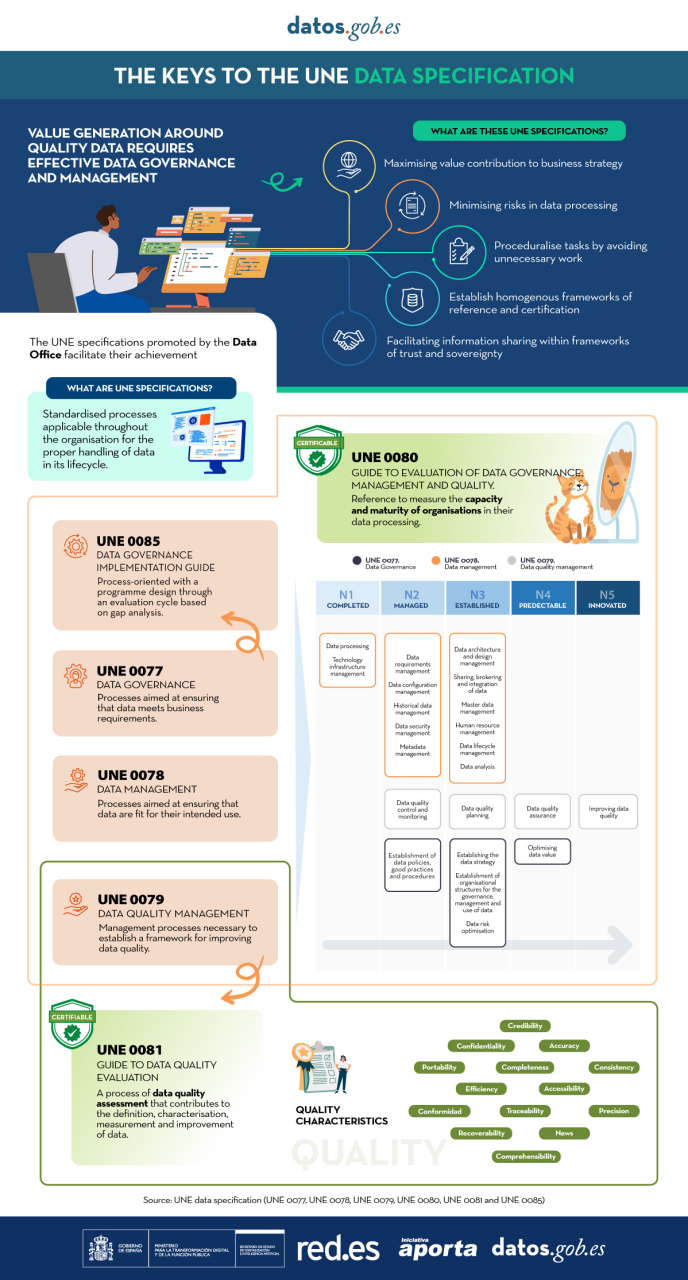
Today, data quality plays a key role in today's world, where information is a valuable asset. Ensuring that data is accurate, complete and reliable has become essential to the success of organisations, and guarantees the success of informed decision making.
Data quality has a direct impact not only on the exchange and use within each organisation, but also on the sharing of data between different entities, being a key variable in the success of the new paradigm of data spaces. When data is of high quality, it creates an environment conducive to the exchange of accurate and consistent information, enabling organisations to collaborate more effectively, fostering innovation and the joint development of solutions.
Good data quality facilitates the reuse of information in different contexts, generating value beyond the system that creates it. High-quality data are more reliable and accessible, and can be used by multiple systems and applications, which increases their value and usefulness. By significantly reducing the need for constant corrections and adjustments, time and resources are saved, allowing for greater efficiency in the implementation of projects and the creation of new products and services.
Data quality also plays a key role in the advancement of artificial intelligence and machine learning. AI models rely on large volumes of data to produce accurate and reliable results. If the data used is contaminated or of poor quality, the results of AI algorithms will be unreliable or even erroneous. Ensuring data quality is therefore essential to maximise the performance of AI applications, reduce or eliminate biases and realise their full potential.
With the aim of offering a process based on international standards that can help organisations to use a quality model and to define appropriate quality characteristics and metrics, the Data Office has sponsored, promoted and participated in the generation of the specification UNE 0081 Data Quality Assessment that complements the already existing specification UNE 0079 Data Quality Management, focused more on the definition of data quality management processes than on data quality as such.
UNE Specification - Guide to Data Quality Assessment
The UNE 0081 specification, a family of international standards ISO/IEC 25000, makes it possible to know and evaluate the quality of the data of any organisation, making it possible to establish a future plan for its improvement, and even to formally certify its quality. The target audience for this specification, applicable to any type of organisation regardless of size or dedication, will be data quality officers, as well as consultants and auditors who need to carry out an assessment of data sets as part of their functions.
The specification first sets out the data quality model, detailing the quality characteristics that data can have, as well as some applicable metrics, and once this framework is defined, goes on to define the process to be followed to assess the quality of a dataset. Finally, the specification ends by detailing how to interpret the results obtained from the evaluation by showing some concrete examples of application.
Data quality model
The guide proposes a series of quality characteristics following those present in the ISO/IEC 25012 standard , classifying them between those inherent to the data, those dependent on the system where the data is hosted, or those dependent on both circumstances. The choice of these characteristics is justified as they encompass those present in other frameworks such as DAMA, FAIR, EHDS, IA Act and GDPR.
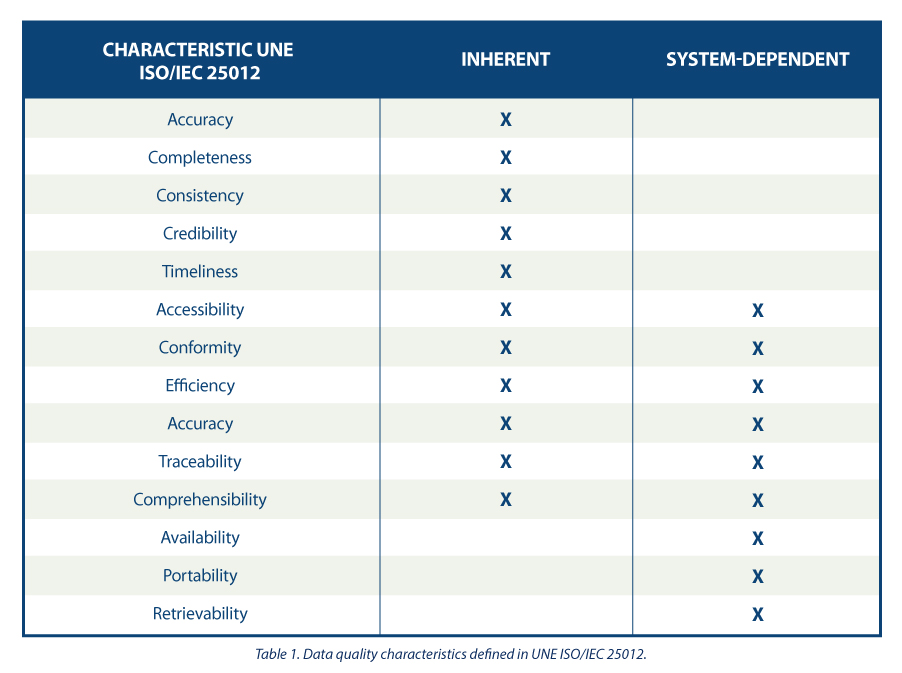
Based on the defined characteristics, the guide uses ISO/IEC 25024 to propose a set of metrics to measure the properties of the characteristics, understanding these properties as "sub-characteristics" of the characteristics.
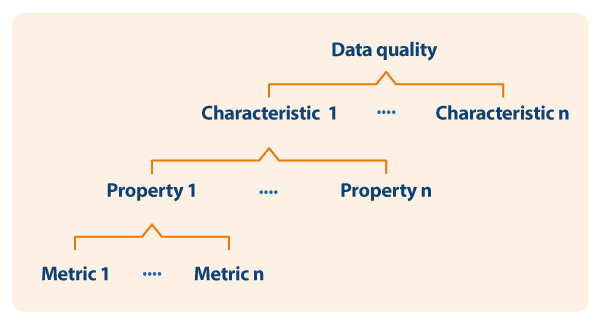
Thus, as an example, following the dependency scheme, for the specific characteristic of "consistency of data format" its properties and metrics are shown, one of them being detailed


Process for assessing the quality of a data set
For the actual assessment of data quality, the guide proposes to follow the ISO/IEC 25040 standard, which establishes an assessment model that takes into account both the requirements and constraints defined by the organisation, as well as the necessary resources, both material and human. With these requirements, an evaluation plan is established through specific metrics and decision criteria based on business requirements, which allows the correct measurement of properties and characteristics and interpretation of the results.
Below is an outline of the steps in the process and its main activities:
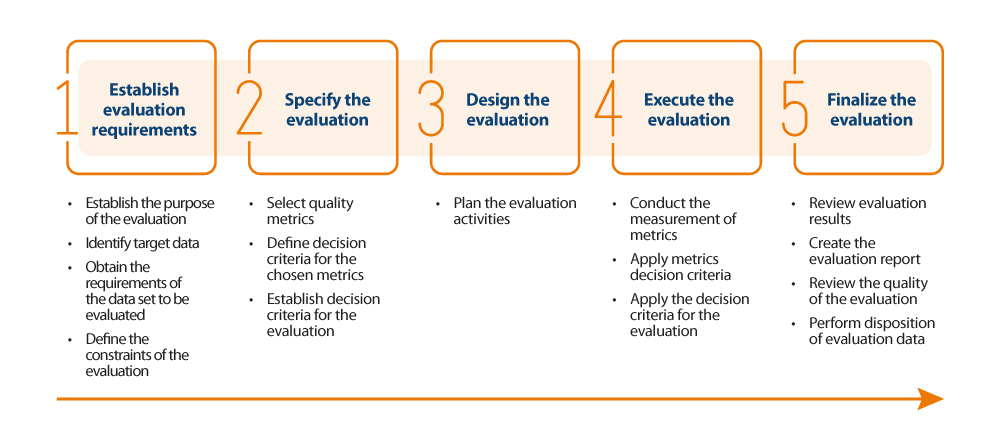
Results of the quality assesment
The outcome of the assessment will depend directly on the requirements set by the organisation and the criteria for compliance. The properties of the characteristics are usually evaluated from 0 to 100 based on the values obtained in the metrics defined for each of them, and the characteristics in turn are evaluated by aggregating the previous ones also from 0 to 100 or by converting them to a discrete value from 1 to 5 (1 poor quality, 5 excellent quality) depending on the calculation and weighting rules that have been established. In the same way that the measurement of the properties is used to obtain the measurement of their characteristics, the same happens with these characteristics, which by means of their weighted sum based on the rules that have been defined (being able to establish more weight to some characteristics than to others), a final result of the quality of the data can be obtained. For example, if we want to calculate the quality of data based on a weighted sum of their intrinsic characteristics, where, because of the type of business, we are interested in giving more weight to accuracy, then we could define a formula such as the following:
Data quality = 0.4*Accuracy + 0.15*Completeness + 0.15*Consistency + 0.15*Credibility + 0.15*Currentness
Assume that each of the quality characteristics has been similarly calculated on the basis of the weighted sum of their properties, resulting in the following values: Accuracy=50%, Completeness=45%, Consistency=35%, Credibility=100% and Currency=50%. This would result in data quality:
Data quality = 0.4*50% + 0.15*45% + 0.15*35% + 0.15*100% + 0.15*50% = 54.5%
Assuming that the organisation has established requirements as shown in the following table:

It could be concluded that the organisation as a whole has a data score of "3= Good Quality".
In summary, the assessment and improvement of the quality of the dataset may be as thorough and rigorous as necessary, and should be carried out in an iterative and constant manner so that the data is continuously increasing in quality, so that a minimum data quality is ensured or can even be certified. This minimum data quality can refer to improving data sets internal to an organisation, i.e. those that the organisation manages and exploits for the operation of its business processes; or it can be used to support the sharing of data sets through the new paradigm of data spaces generating new market opportunities. In the latter case, when an organisation wants to integrate its data into a data space for future brokering, it is desirable to carry out a quality assessment, labelling the dataset appropriately with reference to its quality (perhaps by metadata). Data of proven quality has a different utility and value than data that lacks it, positioning the former in a preferential position in the competitive market.
The content of this guide, as well as the rest of the UNE specifications mentioned, can be viewed freely and free of charge from the AENOR portal through the link below by accessing the purchase section and marking “read” in the dropdown where “pdf” is pre-selected. Access to this family of UNE data specifications is sponsored by the Secretary of State for Digitalization and Artificial Intelligence, Directorate General for Data. Although viewing requires prior registration, a 100% discount on the total price is applied at the time of finalizing the purchase. After finalizing the purchase, the selected standard or standards can be accessed from the customer area in the my products section.
https://tienda.aenor.com/norma-une-especificacion-une-0080-2023-n0071383
https://tienda.aenor.com/norma-une-especificacion-une-0079-2023-n0071118
https://tienda.aenor.com/norma-une-especificacion-une-0078-2023-n0071117
https://tienda.aenor.com/norma-une-especificacion-une-0077-2023-n0071116
Data is a key pillar of digital transformation. Reliable and quality data are the basis of everything, from the main strategic decisions to the routine operational process, they are fundamental in the development of data spaces, as well as the basis of disruptive solutions linked to fields such as artificial intelligence or Big Data.
In this sense, the correct management and governance of data has become a strategic activity for all types of organizations, public and private.
Data governance standardization is based on 4 principles:
- Governance
- Management
- Quality
- Security and data privacy
Those organizations that want to implement a solid governance framework based on these pillars have at their disposal a series of technical standards that provide guiding principles to ensure that an organization's data is properly managed and governed, both internally and by external contracts.
With the aim of trying to clarify doubts in this matter, the Spanish Association for Standardization (UNE), has published various support materials.
The first is an article on the different technical standards to consider when developing effective data governance . The rules contained in said article, together with some additional ones, are summarized in the following infographic:
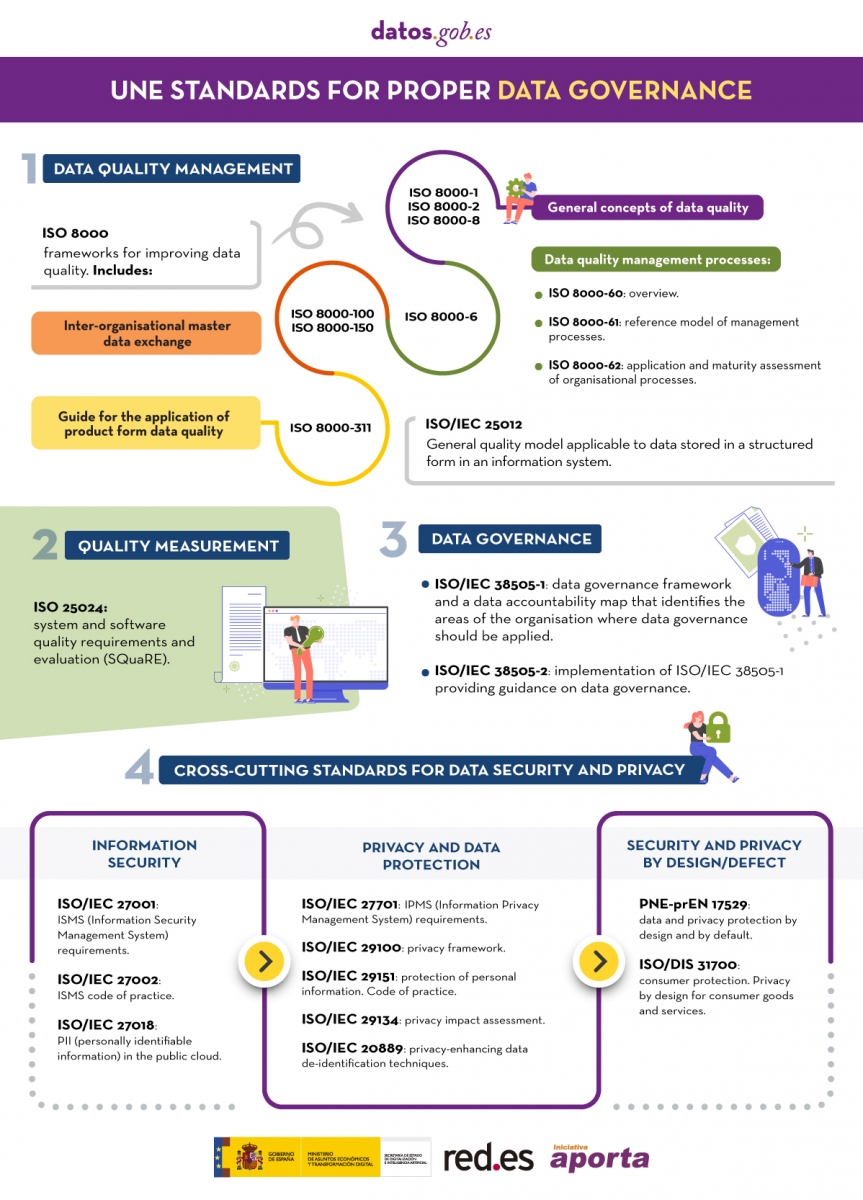
(You can download the accessible version in word here)
In addition, the UNE has also published the report "Standards for the data economy" , which can be downloaded at the end of this article. The report begins with an introduction where the European legislative context that is promoting the Data Economy is deepened and the recognition that it makes of technical standardization as a key tool when it comes to achieving the objectives set. The technical standards included in the previous infographic are analyzed in more detail below.